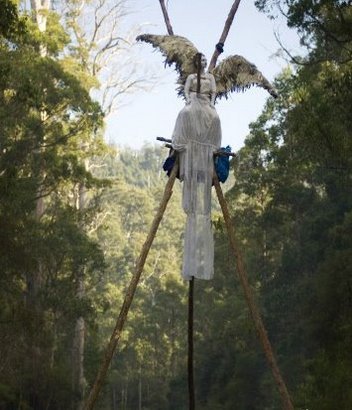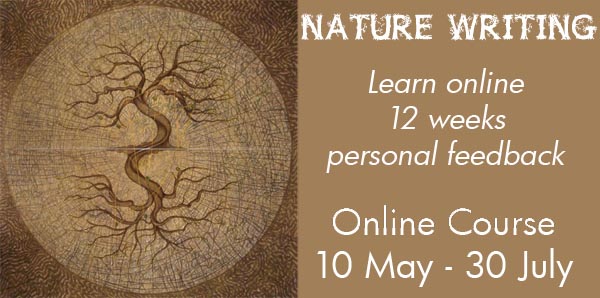
| current issue |
| archives |
| submissions |
| about us |
| contact us |
On Wild Writing by Inga Simpson |
When I read Jay Griffith’s inspirational Wild: An Elemental Journey, I began calling this emerging genre ‘Wild Writing.’ Griffiths refers to our need for wildness, and sees a sickening in ourselves and society when we become too distant from it. Wild, part memoir, travel journal, philosophy, history, and political manifesto, documents Griffiths’ own journey – searching for wildness – though the forests of the Amazon, the Arctic, the Papua New Guinea Highlands, Sulawesi, and the Australian desert:
Wild is overflowing with anger and opinion; scathing at times, about missionaries, golf courses, society, us. It is also meticulously researched, cogently argued, and Griffiths’ words a poetic and sensual delight. It works, I think, because of all of these things, but mostly because Griffiths writes from deep in the heart. From the sales, reviews and publicity for Wild, it appears that Griffiths found many sympathisers. As most people’s daily lives become more and more removed from wildness, from nature, there is a growing questioning of the cost. Recent forecasts about the rapid decline of our environment have focused these anxieties. Sean Penn’s film adaptation of Jon Krakauer’s book Into the Wild
The image, of the actor sitting atop an abandoned bus in the Alaskan wilderness, was on every billboard, every TV station, in every bookstore. The soundtrack, by Eddie Vedder (formerly of Pearl Jam), featuring the same image on its cover, was everywhere, too. The album sold 48 000 copies in the first week and received a Golden Globe award.
Krakauer’s 1996 biography of McCandless and exploration of the ‘call of the wild’, reprinted and now featuring the film cover, was ordered in by the box. Marketing had a lot to do with this, of course, but there was something in us ready to be exploited: a romantic desire to live closer to nature, to walk out of our jobs, apartments, cars, and urban villages, back into nature. Of course, this desire is not new. Thoreau left his everyday city life to build a shack in the wild, and documented his days in Walden. Way back in 1854, Thoreau was concerned about development, the encroachment of man on nature:
Walden’s style – a mix of nature writing, memoir, politics, and philosophy – is echoed in the work of Eric Rolls and Roger Deakin. In his 1988 book, A Million Wild Acres, Rolls, poet, farmer, and self-taught naturalist, explores the history of the Australian ‘forest’ since settlement. Rolls was somewhat controversial at the time, for positing that indigenous Australians controlled forest growth through burning and that what we now call ‘forests’ are a more recent advent. These days, his theories are widely accepted. The book is also a celebration of Northern New South Wales, an area he knew intimately. Roger Deakin was a campaigner, writer and environmentalist. He lived in a highly urbanised country, but sought out and valued the wild places. He lived in a house in Suffolk with a moat, in which he swam regularly. In Waterlog, Deakin swims across Britain, using its pools, lakes, and tarns – wild swimming – providing wonderful description, stories and histories of each area as he goes. In Wild Wood: A journey through trees, he camps out in woods around the world to be at one with the environment and the wildlife. His journey is lined with anecdotes and history; of red-tailed black cockatoos (on a visit to Alice Springs with Ramona Koval), coppicing, walnut farming, the uses of willow, and of drift wood:
When it comes to wild fiction, then, I think first of stories or novels set in the wilderness. Men and women pitting themselves against the elements, setting out into the frontier. Explorers and adventurers journeying deep into the Amazon jungle, or attempting to reach the north pole. Jack London’s Call of the Wild, set in Alaska (and one of the first works written from the point of view of animals) was an early example. Tenderness of Wolves by Stef Penney and Gill Adamson’s Outlander are more recent, popular novels set in the frontier wilds of North America and Canada. Australia, too, is a frontier nation, susceptible to dreams of wildness. Australians have a fond relationship – albeit distant in most cases – with the landscape. It is in our literature, art, film, advertising campaigns; that romanticised notion of Australia as a bush nation, a sunburnt country. We worship it and yet we fear it; fires, floods, shark attacks are daily headlines reminding us how powerful the wild is. We worship those who live rough and outside the rules; bushrangers, explorers, surfers. We know our many wild landscapes – rainforest, wetlands, rivers, oceans – and the creatures that live in them, are at risk.
There is a primacy of physical sensation for Winton’s male characters. In Breath, youngsters Loonie and Pikelet learn to surf, and with the reckless Sando’s encouragement, seek out the big-waves, pushing themselves further and further: Winton’s relationship to the landscape is also a spiritual one. The early short story ‘Wilderness’ features two young bushwalkers who appear as angels to an ex-teacher living as a hermit in the karri forest. The teacher has suffered a nervous breakdown and responded to the biblical command to 'Go into the wilderness and wait'. Winton’s love of the Australian wilderness has led him to write about environmental issues. In ‘Silent Country: Travels Through a Recovering Landscape’, written for The Monthly, Winton reflects on his journey through a recovering Western Australian wheat belt. He notes that “pastoralism may have cost the nation more than it will ever earn” and acknowledges the successful restoration if the area by individuals who have “taken conservation into their own hands”. Similarly, in his Monthly article ‘Out of Control: The tragedy of Tasmania’s forests’, author and journalist Richard Flanagan campaigned against Gunn’s actions in Tasmania. Flanagan’s writing reveals a passionate knowledge and understanding of this wild patch of Australia. The article was used to campaign against a proposed pulp mill in the Tamar Valley and against former Prime Minster John Howard, distributed to every letterbox in the seat of Wentworth during the 2007 election campaign. Eco-terrorists and activists, in publications like Green Anarchy, call for ‘rewilding’ – a greener form of anarchy – an end of civilisation, returning to a more primitive and natural state. Christopher McCandless was putting some version of this into practice when he set off into the wilds of Alaska, abandoning the trappings of society and trying to live off the land.
For me, wildness is being away from civilisation, in nature. When I am surrounded by trees or inside a wave I feel invigorated and free. Inspired. It is what I need to feel balanced and write bravely. Writing wild need not, however, be living wild; taking on the wilderness, trying to save it, or living rough. Writing that is otherwise elemental; featuring pure thoughts, pure passion, pure sex, or texts that are otherwise marginal, outside the mainstream, also come into the ‘wild’ frame. Gillian Mears, who has been compared to Winton for the centrality of the Australian landscape to her work, creates extraordinary characters, revelling in their flaws and idiosyncrasies. Her most recent collection of short stories, A Map of the Gardens, aims to unsettle, exploring dependency and co-dependency, shadowy sexual relationships and the gaps between public and private behaviour. Krissy Kneen’s collection of short erotic stories, Swallow the Sound, also takes the reader into uncomfortable ground, featuring sensual relationships between son and step-mother, carer and mentally-disabled woman, and conjoined twins, Ellie and Rachel:
Writing wild is to be open, to allow your words, your process, to take you in directions you may not have anticipated. In the preface to David Bohm’s On Creativity, Leroy Little Bear describes the mind as:
The act of wild writing is to tap into the more elemental parts of our nature. To strip away distractions, affectations, doubts and inhibitions. To express our deeper emotions and thoughts, to write with conviction, to dare.
Bibliography |
 Over the last eighteen months, I have been researching, well … trees. Trees and forests, woods and wilderness, climate change and eco-terrorists. In the process, I have noticed an upsurge on the ‘popular science’, ‘eco-science’ or ‘natural science’ shelves of bookstores. Where there were once a dozen titles to select from, now there are whole sections. Titles I had to order on-line a year ago are now stocked in bulk in major bookstores. Titles out of print have been repackaged to feed a new appetite. Subjects include sustainable living, trees, birds, tree-change, sea change, and, of course, climate change. Key titles include: Jim Krakauer’s Into the Wild, Roger Deakin’s Wildwood: A Journey Through Trees, and Wild Trees by Robert Preston. One book store owner commented that attaching ‘wild’ to a book title sees it walking out the door.
Over the last eighteen months, I have been researching, well … trees. Trees and forests, woods and wilderness, climate change and eco-terrorists. In the process, I have noticed an upsurge on the ‘popular science’, ‘eco-science’ or ‘natural science’ shelves of bookstores. Where there were once a dozen titles to select from, now there are whole sections. Titles I had to order on-line a year ago are now stocked in bulk in major bookstores. Titles out of print have been repackaged to feed a new appetite. Subjects include sustainable living, trees, birds, tree-change, sea change, and, of course, climate change. Key titles include: Jim Krakauer’s Into the Wild, Roger Deakin’s Wildwood: A Journey Through Trees, and Wild Trees by Robert Preston. One book store owner commented that attaching ‘wild’ to a book title sees it walking out the door.